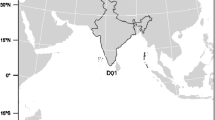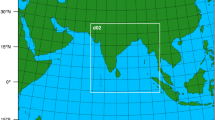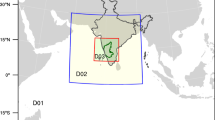Abstract
The present study examines the impact of assimilation of atmospheric motion vectors (AMV) from the INSAT-3D satellite in two different data assimilation (DA) systems using the Weather Research and Forecast model. INSAT-3D is a weather satellite launched by the Indian Space Research Organization and the wind products are derived from imager channels in the payload. Five tropical cyclones (TC) with intensity ranging from very severe cyclonic storm to super cyclone formed over the Bay of Bengal is considered. Observing system experiments are conducted in three-dimensional variational (3DVAR) and hybrid ensemble transform Kalman filter-3DVAR (HYBRID) DA techniques. The results indicate that the error in the initial position and intensity of TC are lower in HYBRID than in 3DVAR, however, with no substantial improvements due to the assimilation of INSAT-3D AMV. In contrast, the forecast of the track shows positive impact of AMV in both the DA system. The TC landfall position error has reduced due to the assimilation of AMV in HYBRID DA system while the impact of AMV on intensity forecast remains nominal. Further analysis revealed that the assimilation of AMV data has improved the rainfall forecast in both HYBRID and 3DVAR experiments and HYBRID experiments show improved skill scores for precipitation forecast as compared to other experiments, in general.


available at 00 UTC 10 October 2014








Similar content being viewed by others
Availability of data and material
The NCEP global forecast system analyses and forecasts data that is utilized in this study are openly available in the repository https://rda.ucar.edu at https://doi.org/10.5065/D65Q4TSG. Data assimilation is performed using observations derived from NCEP ADP Global Upper Air and Surface Weather Observations archived in the https://rda.ucar.edu at https://doi.org/10.5065/Z83F-N512 and INSAT-3D satellite derived atmospheric motion vectors from https://www.mosdac.gov.in.
Code availability
The atmospheric model used in this study is Weather Research and Forecast (ARW-WRF) of version 3.8.1, which is openly available for download in https://www2.mmm.ucar.edu/wrf/users/download/get_sources.html. The data assimilation package comes from WRFDA system of 3.8.1 version archived in https://www2.mmm.ucar.edu/wrf/users/download/get_sources.html#WRFDA.
References
Chen S, Vandenberghe F, Petty GW, Bresch JF (2004) Application of SSM/I satellite data to a hurricane simulation. Q J R Meteorol Soc A J Atmos Sci Appl Meteorol Phys Oceanogr 130:801–825
Deb SK, Kishtawal CM, Pal PK (2010) Impact of Kalpana-1-derived water vapor winds on Indian Ocean tropical cyclone forecasts. Mon Weather Rev 138:987–1003
Deb SK, Kumar P, Pal PK, Joshi PC (2011) Assimilation of INSAT data in the simulation of the recent tropical cyclone Aila. Int J Remote Sens 32:5135–5155
Deb SK, Kishtawal CM, Kumar P et al (2016) Atmospheric motion vectors from INSAT-3D: initial quality assessment and its impact on track forecast of cyclonic storm NANAUK. Atmos Res 169:1–16
Emanuel K, Zhang F (2017) The role of inner-core moisture in tropical cyclone predictability and practical forecast skill. J Atmos Sci 74:2315–2324. https://doi.org/10.1175/JAS-D-17-0008.1
Greeshma MM, Srinivas CV, Yesubabu V et al (2015) Impact of local data assimilation on tropical cyclone predictions over the Bay of Bengal using the ARW model. Ann Geophys 33:805–828
Hamill TM, Whitaker JS, Kleist DT et al (2011) Predictions of 2010s tropical cyclones using the GFS and ensemble-based data assimilation methods. Mon Weather Rev 139:3243–3247
Heming JT, Prates F, Bender MA et al (2019) Review of recent progress in tropical cyclone track forecasting and expression of uncertainties. Trop Cyclone Res Rev 8:181–218
Jing-Yao L, Bao-De C, Hong L et al (2013) Typhoon track forecast with a hybrid GSI-ETKF data assimilation system. Atmos Ocean Sci Lett 6:161–166
Kalnay E (2003) Atmospheric modeling, data assimilation and predictability. Cambridge University Press
Kalra S, Kumar S, Routray A (2019) Simulation of heavy rainfall event along east coast of India using WRF modeling system: impact of 3DVAR data assimilation. Model Earth Syst Environ 5(1):245–256
Kelly G, Thépaut J-N, Buizza R, Cardinali C (2007) The value of observations. I: data denial experiments for the Atlantic and the Pacific. Q J R Meteorol Soc 133:1803–1815. https://doi.org/10.1002/qj.150
Ku J, Kutty G, George B (2020) On the predictability and dynamics of tropical cyclone: Nargis (2008). J Geophys Res Atmos 125:e2019JD032040. https://doi.org/10.1029/2019JD032040
Kumar P, Deb SK, Kishtawal CM, Pal PK (2017) Impact of assimilation of INSAT-3D retrieved atmospheric motion vectors on short-range forecast of summer monsoon 2014 over the south Asian region. Theor Appl Climatol 128:575–586
Kutty G, Wang X (2015) A comparison of the impacts of radiosonde and AMSU radiance observations in GSI based 3DEnsVar and 3DVar data assimilation systems for NCEP GFS. Adv Meteorol 2015:17. https://doi.org/10.1155/2015/280546
Kutty G, Muraleedharan R, Kesarkar AP (2018) Impact of representing model error in a hybrid ensemble-variational data assimilation system for track forecast of tropical cyclones over the Bay of Bengal. Pure Appl Geophys 175:1155–1167
Lewis WE, Velden CS, Stettner D (2020) Strategies for assimilating high-density atmospheric motion vectors into a regional tropical cyclone forecast model (HWRF). Atmosphere (basel) 11:673
Li M, Zhang S, Wu L et al (2020) An examination of the predictability of tropical cyclone genesis in high-resolution coupled models with dynamically downscaled coupled data assimilation initialization. Adv Atmos Sci 37:939–950
Lim AHN, Jung JA, Nebuda SE et al (2019) Tropical cyclone forecasts impact assessment from the assimilation of hourly visible, shortwave, and clear-air water vapor atmospheric motion vectors in HWRF. Weather Forecast 34:177–198
Lorenc AC (2003) The potential of the ensemble Kalman filter for NWP: a comparison with 4D-Var. Q J R Meteorol Soc A J Atmos Sci Appl Meteorol Phys Oceanogr 129:3183–3203
Lu X, Wang X, Li Y et al (2017) GSI-based ensemble-variational hybrid data assimilation for HWRF for hurricane initialization and prediction: impact of various error covariances for airborne radar observation assimilation. Q J R Meteorol Soc 143:223–239
Malakar P, Kesarkar AP, Bhate J, Deshamukhya A (2020a) Appraisal of data assimilation techniques for dynamical downscaling of the structure and intensity of tropical cyclones. Earth Space Sci 7:e2019EA000945
Malakar P, Kesarkar AP, Bhate JN et al (2020b) Comparison of reanalysis data sets to comprehend the evolution of tropical cyclones over North Indian Ocean. Earth Space Sci 7:e2019EA000978
Mlawer EJ, Taubman SJ, Brown PD et al (1997) Radiative transfer for inhomogeneous atmospheres: RRTM, a validated correlated-k model for the longwave. J Geophys Res Atmos 102:16663–16682
Mohanty UC, Osuri KK, Tallapragada V et al (2015) A great escape from the Bay of Bengal Super Sapphire-Phailin Tropical cyclone: a case of improved weather forecast and societal response for disaster mitigation. Earth Interact 19:1–11
Parrish DF, Derber JC (1992) The National Meteorological Center’s spectral statistical-interpolation analysis system. Mon Weather Rev 120:1747–1763
Raju PVS, Potty J, Mohanty UC (2012) Prediction of severe tropical cyclones over the Bay of Bengal during 2007–2010 using high-resolution mesoscale model. Nat Hazards 63:1361–1374
Sawada M, Ma Z, Mehra A et al (2020) Assimilation of Himawari-8 rapid-scan atmospheric motion vectors on tropical cyclone in HWRF system. Atmosphere (basel) 11:601
Shen F, Min J, Xu D (2016) Assimilation of radar radial velocity data with the WRF Hybrid ETKF–3DVAR system for the prediction of Hurricane Ike (2008). Atmos Res 169:127–138. https://doi.org/10.1016/j.atmosres.2015.09.019
Singh KS, Tyagi B (2019) Impact of data assimilation and air- sea flux parameterization schemes on the prediction of cyclone Phailin over the Bay of Bengal using the WRF-ARW model. Meteorol Appl 26:36–48
Singh R, Kishtawal CM, Pal PK, Joshi PC (2011) Assimilation of the multisatellite data into the WRF model for track and intensity simulation of the Indian Ocean tropical cyclones. Meteorol Atmos Phys 111:103–119
Singh KS, Albert J, Bhaskaran PK, Alam P (2021) Numerical simulation of an extremely severe cyclonic storm over the Bay of Bengal using WRF modelling system: influence of model initial condition. Model Earth Syst Environ 2021:1–12
Skamarock WC, Klemp JB, Dudhia J et al (2008) 2005: a description of the advanced research WRF version 2. In: NCAR Tech. Note
Soden BJ, Velden CS, Tuleya RE (2001) The impact of satellite winds on experimental GFDL hurricane model forecasts. Mon Weather Rev 129:835–852
Torn RD, Hakim GJ, Snyder C (2006) Boundary conditions for limited-area ensemble Kalman filters. Mon Weather Rev 134:2490–2502
Wang X (2011) Application of the WRF hybrid ETKF–3DVAR data assimilation system for hurricane track forecasts. Weather Forecast 26:868–884
Wang X, Barker DM, Snyder C, Hamill TM (2008) A hybrid ETKF–3DVAR data assimilation scheme for the WRF model. Part I: observing system simulation experiment. Mon Weather Rev 136:5116–5131
Wang J, Xu Y, Yang L et al (2020) Data assimilation of high-resolution satellite rainfall product improves rainfall simulation associated with landfalling tropical cyclones in the Yangtze river Delta. Remote Sens 12:276
Willemet JM, Lasserre-Bigorry A (2001) 4.3 satellite data assimilation: impact on tropical cyclone forecast
Wu T-C, Liu H, Majumdar SJ et al (2014) Influence of assimilating satellite-derived atmospheric motion vector observations on numerical analyses and forecasts of tropical cyclone track and intensity. Mon Weather Rev 142:49–71
Xu D, Liu Z, Huang X-Y et al (2013) Impact of assimilating IASI radiance observations on forecasts of two tropical cyclones. Meteorol Atmos Phys 122:1–18
Zhang R, Zhang W, Zhang Y et al (2020) Application of lightning data assimilation to numerical forecast of super typhoon Haiyan (2013). J Meteorol Res 34:1052–1067
Acknowledgements
The authors gratefully acknowledge Mesoscale and Microscale Meteorology division at the National Center for Atmospheric Research (NCAR) for its support for WRF modeling and assimilation systems (http://www.mmm.ucar.edu/wrf). We also thank the National Centers for Environmental Prediction (NCEP) for making available the analysis and observation data for conducting the experiments. The authors acknowledge Indian Meteorological Division (IMD) for making available the best track data for validation and the IITM high-performance computing facility used for computing is acknowledged gratefully.
Author information
Authors and Affiliations
Contributions
RBG performed the experiments and wrote the manuscript. GK analyzed the results. GK and AB supervised the research work.
Corresponding author
Additional information
Publisher's Note
Springer Nature remains neutral with regard to jurisdictional claims in published maps and institutional affiliations.
Rights and permissions
About this article
Cite this article
Gogoi, R.B., Kutty, G. & Borgohain, A. Impact of INSAT-3D satellite-derived wind in 3DVAR and hybrid ensemble-3DVAR data assimilation systems in the simulation of tropical cyclones over the Bay of Bengal. Model. Earth Syst. Environ. 8, 1813–1823 (2022). https://doi.org/10.1007/s40808-021-01183-8
Received:
Accepted:
Published:
Issue Date:
DOI: https://doi.org/10.1007/s40808-021-01183-8




